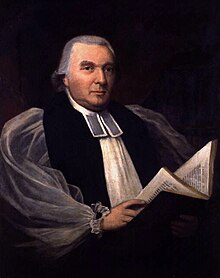St. James Episcopal Church (New London, Connecticut)
The building was added to the National Register of Historic Places in 2004.
History and architecture

First church
St. James was formed on June 6, 1725, and the first building, a wooden structure located on New London's Parade, was opened in 1732. An arrow was shot into the gilt wooden ball at the top of the steeple by the chief of a visiting Native American delegation. The arrow hung there until the church was destroyed in 1781.
During the American Revolution, a number of the Parish members were loyalists. Services stopped between mid-1775 and the fall of 1778 since tensions were high regarding the use of prayers for the King and Royal Family, and in 1778, the Parish voted "that no person be permitted to...act as a pastor...unless he openly prays for Congress...." The church was destroyed by a fire set in New London on September 6, 1781 during the Battle of Groton Heights. British forces in New London during that engagement were under the command of Brigadier General Benedict Arnold, a native of nearby Norwich.
Samuel Seabury
After his consecration in Aberdeen Scotland on November 14, 1784, as the first bishop of the Episcopal Church (United States), Bishop Samuel Seabury (1729–1796) returned to New London in 1785 as rector of St. James. He died in New London on February 25, 1796, and is now buried in Hallam Chapel located in the undercroft of St. James. A cenotaph designed by architect Richard Upjohn is located on the north side of the sanctuary, and his original grave slab is located outdoors on the north side of the church, now covered by a duplicate.
Second church
A new church was consecrated on September 20, 1787, near the current site of the Salvation Army building in New London. This was the building that served Bishop Seabury. As the Parish began to grow during the mid-1800s, it was clear that a larger building was needed.
Third church
This building, the congregation's current one, was designed by English-born architect Richard Upjohn in the Gothic Revival style. The cornerstone was laid November 3, 1847, and the church was consecrated on June 11, 1850. It was built in a cruciform style with north and south transepts. There is a very prominent bell tower on the northwest corner. St. James is an excellent example of Upjohn's architectural style. It is notable that St. James was started the year after Upjohn completed Trinity Church (Manhattan). The New York Ecclesiological Society criticized Upjohn for the "moorish" design of the roof bracing in St. James, however, it was well received locally.
Rectory
The rectory is located on Huntington St. in one of four Greek Revival houses built between 1835 and 1845 known as Whale Oil Row. This row of buildings is unique in Connecticut, and possibly the United States, and documents the lifestyle of their wealthy owners who worked in the whaling industry of that time.


